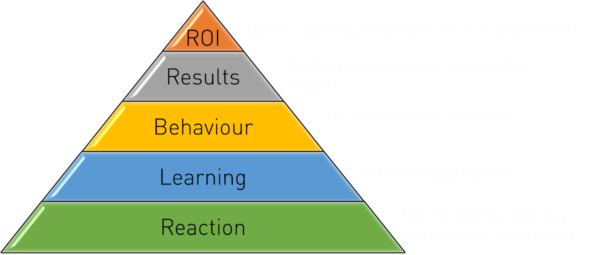Coaching is proven to be an effective way of implementing positive change to a business and is becoming increasingly popular. The evaluation of coaching is often neglected. Benefits are anticipated before delivery, but frequently without a structure or framework that considers the full potential for the organization. Once the coaching has been delivered the achieved impact is rarely reviewed to identify whether the coaching has been successful, where future effort would be best applied, and whether any change should be explored as a result of the coaching.
The Institute for Employment Studies’ ‘Practical Methods For Evaluating Coaching’ report includes several examples of measurable benefits of coaching.
Measuring benefits to the organisation
- People-based benefits include positive changes to employee attitudes, corporate climate, retention and motivation levels, staff absence, customer satisfaction and complaints, credibility, reputation, and satisfaction among external stakeholders.
- Business performance benefits include positive changes to sales and/or turnover, market share, new customers, productivity, development of new products and/or services, product and service quality, task time, product development time, production time.
Measuring benefits to the individual
Benefits to the individual are sometimes less tangible. Measurement of the development and transfer of knowledge is frequently subjective. The use of 360-degree feedback ratings, employee and job performance appraisal can provide measures of these benefits.
Models for evaluating coaching
There are two models commonly used for evaluating coaching:
- Relevance – Alignment – Measurement. The RAM model is forward-looking and assesses the future value of coaching against the impact that coaching is likely to have.
- Kirkpatrick Model of Evaluation. This is a reflective model that looks at the effectiveness of a delivered program of coaching.
RAM Relevance – Alignment – Measurement Model
The ‘RAM’ model (Relevance – Alignment – Measurement) was developed by the Chartered Institute for Personnel and Development. It’s a useful model with a wide scope that takes a forward-looking view to consider the rationale for sanctioning a coaching programme at an organisational level.
- Relevance. What is the business case for the coaching intervention? Understanding the issue(s) that it is to address, and how it will drive the business forward in terms of skills, productivity, and cost effectiveness.
- Alignment. Understanding the potential impact on the organization, including the positive benefits of achieving coaching objectives versus the impact of delivery including the cost of coaching measured as money and time to be invested.
- Measurement. Analysing qualitative and quantitative measurements of the performance improvement initiatives to understand the impact of the coaching against the organisation’s operational and financial KPIs.
Kirkpatrick Model of Evaluation
The Kirkpatrick Model of Evaluation was originally developed for training evaluation and its use is now widespread in coaching. It is hierarchical and different organisations may choose to evaluate the effectiveness of coaching to a different tier of the model. Smaller organisations may derive sufficient understanding of coaching effectiveness from the Reaction, or Reaction and Learning stages without the time investment to look at the higher stages.

- Reaction. Results of this stage are easy to comprehend. They give a general picture to act as a baseline but can be simplistic rather than of significant value and are subject to the subjective whims of the respondent. It is questionable whether coaching sessions should be adjusted purely based on this stages’ results.
- Learning. Focused on knowledge and skills this can be difficult to measure involving significant amounts of work to gather the necessary data if skills and knowledge are to be assessed both before and after the coaching sessions. It’s useful to the organisation because it provides a measure of advancement achieved by the coachee.
- Behaviour. Is the coachee is applying the knowledge and skills to their daily responsibilities and how is this affecting their performance? This can be time and resource hungry which may curb the enthusiasm to take this measure.
- Results. Focusing on the impact on the organisation and of interest to the senior management team. The biggest issue here is how proof is obtained that it was the coaching that generated the impact, or to what degree. This could take considerable time and add significant cost to the overall project.
- Return on Investment. Has the investment in coaching generated a positive return on investment?
If you would like to learn more about how WLP can help you or your business benefit from coaching, get in touch today.
